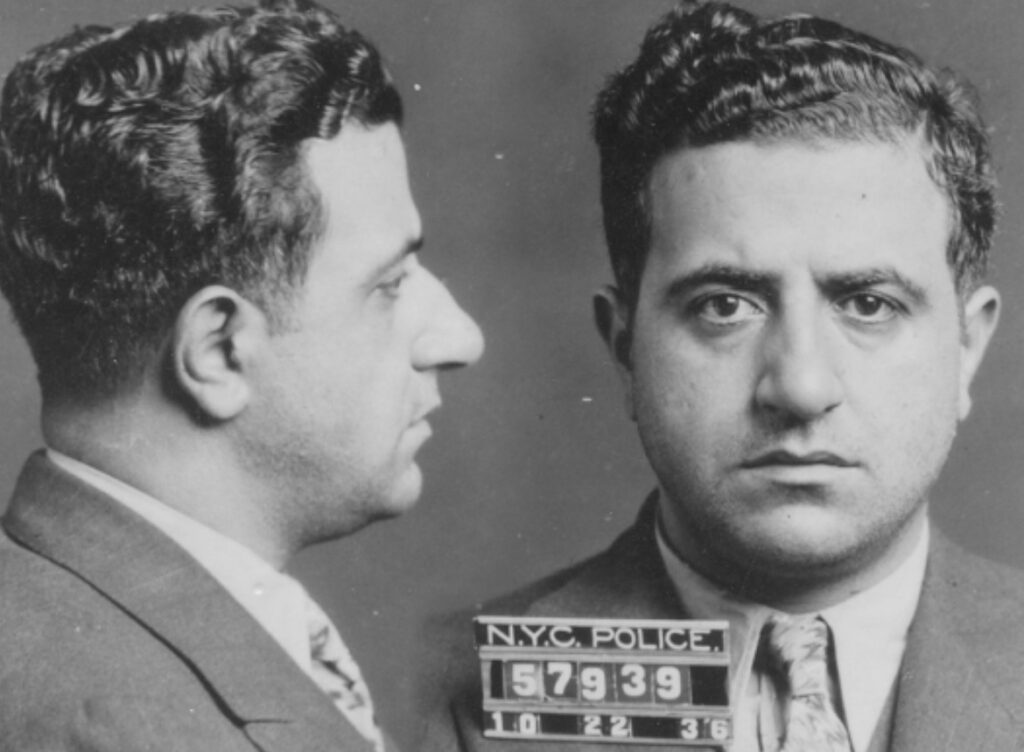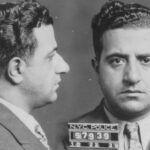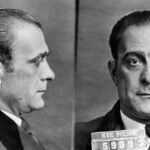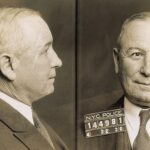Albert Anastasia, born Umberto Anastasio on September 26, 1902, in Tropea, Calabria, Italy, embarked on a path that would etch his name into the annals of American organized crime history. His journey to the United States, alongside his brothers, marked the beginning of a saga steeped in intrigue and power struggles. The death of his father, a railway worker, left the family in hardship, propelling the young Anastasia toward a life far removed from the ordinary.
The Brooklyn Waterfront – A Gateway to Power
The Brooklyn waterfront, a bustling hub of activity in the early 20th century, served as a crucial backdrop to Albert Anastasia’s ascent in the criminal world. This area, teeming with ships, cargo, and workers, was not just a center of commerce but a fertile ground for illicit activities. Anastasia, with his keen understanding of the waterfront’s dynamics, quickly recognized the potential for power and influence. The docks were more than just a workplace; they were a nexus of corruption, where the lines between legal and illegal were often blurred.
Anastasia’s entry into this world as a longshoreman was the first step in a journey that would see him become a master of manipulation and control. The waterfront was riddled with labor disputes, smuggling operations, and extortion rackets, all of which presented opportunities for an ambitious individual like Anastasia. His ability to navigate this complex environment, coupled with his ruthless determination, set him apart from his peers. He didn’t just work at the docks; he started to own them in a manner that went far beyond mere employment.
The Rise of a Mobster
Albert Anastasia’s rise in the underworld was not a matter of chance but a calculated series of moves marked by violence, alliances, and strategic thinking. The incident in 1921, where he faced a death sentence for the murder of a fellow longshoreman, was a critical moment. The overturning of this sentence in a retrial was a testament to his growing influence and ability to manipulate the system. This event was more than just a legal victory; it was a declaration of his resilience and cunning, qualities essential for survival and success in the mob world.
Following this, Anastasia didn’t just return to his old life; he emerged with a heightened reputation, now seen as someone who could face down death and emerge unscathed. This reputation was a currency in the underworld, and Anastasia invested it wisely. He began forging key alliances, understanding that in the world of organized crime, connections were as important as brute strength. His ties with future Cosa Nostra bosses and his involvement in various criminal activities were calculated moves, positioning him as a formidable player in the mob hierarchy.
Anastasia’s journey from a longshoreman to a mobster was marked by his ability to see and seize opportunities, his willingness to engage in violence, and his shrewdness in forming alliances. Each step he took was a building block in creating the legacy of a man who would become one of the most feared figures in the history of American organized crime.
The Formation of Murder, Inc.
In the shadowy corners of the Brooklyn waterfront, a sinister plan was taking shape in the late 1920s and early 1930s. Albert Anastasia, already a figure of considerable influence within the International Longshoremen’s Association, was extending his reach into more ominous territories. His control over the waterfront was not just about overseeing the flow of goods; it was about mastering the flow of power and fear. Anastasia’s alliances with key mob figures like Joe Adonis and Vincent Mangano were strategic, but it was his central role in the creation of Murder, Inc. that truly defined his legacy in the annals of organized crime.
Murder, Inc., a name that would send shivers down the spine of even the most hardened individuals, was not just a group of hitmen; it was a sophisticated machine of death, operating with chilling efficiency. Anastasia’s involvement in this organization showcased his organizational skills and his ruthless approach to dealing with obstacles. Under his leadership, Murder, Inc. became a pivotal tool in the enforcement arm of the Mafia, responsible for an alarming number of murders. The sheer scale of their operations, estimated to be responsible for hundreds of killings, underscored the terrifying reach of Anastasia’s influence. His nicknames, “The Mad Hatter” and “Lord High Executioner,” were well-earned, reflecting both his unpredictable nature and his role as the arbiter of life and death.
The Castellammarese War and Its Aftermath
The early 1930s in New York’s underworld were anything but stable. The Castellammarese War, a bloody power struggle that tore through the heart of the Mafia, set the stage for a seismic shift in the organized crime landscape. Anastasia, ever the opportunist, played a pivotal role in this conflict. His alliance with Charles “Lucky” Luciano wasn’t just a meeting of minds; it was a strategic move that would reshape the Mafia’s future.
Anastasia’s participation in the assassination of Giuseppe “Joe the Boss” Masseria was a critical moment in this war. This act was not merely a murder; it was a statement, signaling the end of the old guard and the dawn of a new era in organized crime. Luciano’s subsequent rise to power marked a significant transformation in the Mafia’s structure, leading to the establishment of the Five Families. Anastasia’s appointment as underboss of the Mangano crime family, which would later evolve into the Gambino family, was a testament to his strategic acumen and his ability to navigate the treacherous waters of Mafia politics.
In these roles, Anastasia demonstrated a unique blend of tactical intelligence and brute force. His involvement in the Castellammarese War was not just about choosing sides; it was about shaping the future of the Mafia in America. His actions during this period laid the groundwork for the modern structure of organized crime, a legacy that would endure long after his death.
The Reign of the Anastasia Crime Family
The 1950s marked the pinnacle of Albert Anastasia’s criminal career, a period where his influence and control over the New York underworld were unparalleled. After the disappearance of Vincent Mangano, Anastasia seized control of the family, reshaping it into the Anastasia crime family. This era was not just about maintaining the status quo; it was about aggressive expansion and consolidation of power. Anastasia’s rule was characterized by a relentless pursuit of dominance in various sectors, notably the labor and garment industries. His methods were ruthless, often involving intimidation and violence, which earned him a dual reputation of respect and fear within the criminal underworld and beyond.
Anastasia’s approach to running the family was revolutionary. He expanded the family’s operations beyond traditional rackets, venturing into new territories and establishing a diverse portfolio of criminal activities. This expansion was not without its challenges. Anastasia’s reign was constantly under scrutiny, not just from law enforcement agencies but also from within the Mafia itself. His leadership style, marked by bold moves and a refusal to bow to external pressures, created a complex web of alliances and rivalries. Despite these challenges, Anastasia’s grip on the family remained firm, a testament to his strategic acumen and his ability to navigate the treacherous waters of organized crime.
The Downfall and Assassination
Albert Anastasia’s downfall was a dramatic chapter in the annals of Mafia history, marked by betrayal and power struggles. His aggressive expansionist policies and unyielding nature created friction within the Mafia’s ranks, particularly with Vito Genovese. Genovese, with ambitions to ascend to the pinnacle of the Luciano family, viewed Anastasia as a formidable barrier to his aspirations. The tension between these two powerful figures was not just a personal rivalry; it was a clash of ideologies and visions for the future of the Mafia.
The alliance between Genovese and Carlo Gambino, a key figure within Anastasia’s own ranks, was a critical turning point. This partnership was forged in secrecy, a strategic move that would lead to one of the most notorious assassinations in Mafia history. The plot against Anastasia was a carefully orchestrated plan, a culmination of years of simmering tensions and strategic positioning.
The assassination of Albert Anastasia on October 25, 1957, was a moment that shook the foundations of the Mafia. The brazen attack in the barber shop of the Park Sheraton Hotel was not just the end of a man but the end of an era. The murder, executed with chilling precision, sent shockwaves through the criminal underworld and marked a significant shift in the power dynamics within the Mafia. The aftermath of Anastasia’s death saw the rise of Carlo Gambino, who would go on to lead the family to new heights. This transition of power was a pivotal moment, signaling a change in the leadership style and direction of one of the most powerful crime families in America. The legacy of Anastasia’s reign, marked by ambition, ruthlessness, and a relentless pursuit of power, would continue to influence the operations and ethos of the Gambino family for years to come.
Legacy and Impact on Organized Crime
Albert Anastasia left an indelible mark on the landscape of organized crime, a legacy that extends far beyond his lifetime. His pivotal role in the formation and operation of Murder, Inc. revolutionized the Mafia’s approach to enforcing its will and resolving disputes. Under Anastasia’s guidance, Murder, Inc. became a symbol of the Mafia’s ruthlessness and efficiency, setting a new standard for organized crime operations. The group’s activities in contract killings not only instilled fear but also established a system of retribution and control that became a hallmark of Mafia operations.
Anastasia’s influence extended beyond the dark alleys of contract killings. His control over the Brooklyn waterfront and his leadership within the International Longshoremen’s Association (ILA) showcased a sophisticated understanding of labor relations and union dynamics. He manipulated these entities to the Mafia’s advantage, turning the waterfront into a lucrative source of income and power. This control of labor unions was not just about financial gain; it was about exerting influence and solidifying the Mafia’s presence in legitimate sectors of society. Anastasia’s ability to bridge the underworld and the legitimate world demonstrated a level of sophistication and foresight that was ahead of his time.
Anastasia in Popular Culture
Albert Anastasia’s life, characterized by violence, power, and a dramatic end, has captivated the imagination of writers, filmmakers, and audiences alike. His story has been chronicled in numerous books, films, and television shows, each portrayal adding to the mystique of this legendary figure. In popular culture, Anastasia is often depicted as the epitome of the ruthless mobster, a symbol of the American Mafia’s power and influence during its golden era. His life story resonates not just as a tale of crime but as a complex narrative of ambition, power, and downfall.
The fascination with Anastasia in popular culture reflects a broader intrigue with the Mafia’s operations and its characters. His portrayal in media often highlights the dichotomy of his personality – a ruthless killer and a shrewd businessman. These portrayals contribute to the public’s understanding of the Mafia’s inner workings and its impact on American society. Anastasia’s life story, as depicted in various media, serves as a window into a bygone era of organized crime, offering insights into the complexities and contradictions of one of its most notorious figures.
Albert Anastasia’s legacy in the world of organized crime and his portrayal in popular culture underscore his significance as a key figure in the history of the American Mafia. His influence on organized crime operations and his depiction in media have cemented his status as an iconic figure in the annals of crime, a status that continues to fascinate and intrigue to this day.
Wrapping It Up
Albert Anastasia’s journey from a struggling immigrant to a feared mob boss encapsulates the complex dynamics of power, loyalty, and betrayal within the American Mafia. His life story, marked by violence, cunning, and ambition, offers a window into the inner workings of organized crime and its impact on American society. Anastasia’s legacy continues to fascinate and horrify, a testament to the enduring allure of the Mafia’s shadowy world.







